Evaluating the Effectiveness of Seepage Countermeasures and Retrofitting Strategies for Mitigating Nappe Flow-Induced Reverse Flow and Erosion for Overtopping Flow from a Levee
Abstract
1. Introduction
2. Materials and Methodology
2.1. Experimental Setup and Test Configurations
2.2. Soil Parameters and Materials
2.3. Hydraulic Conditions and Experimental Procedure
2.4. Scaling Principles and Methods
2.5. Replications and Limitations of Scale
2.6. Measurements and Data Collection
3. Results
3.1. Control Case (Case 1 CCNHD)
3.1.1. Erosion Profile at 120 Seconds
3.1.2. Final Erosion Profile
3.2. Full-Length Horizontal Drainage Layers (Case 2: HD15L50 and Case 3: HD25L50)
3.2.1. Erosion Profile at 120 Seconds
3.2.2. Final Erosion Profile
3.3. Partial-Length Horizontal Drainage Layers (Case 4: HD15L40 and Case 5: HD25L40)
3.3.1. Erosion Profile at 120 Seconds
3.3.2. Final Erosion Profile
3.4. Reduced-Length Horizontal Drainage Layers (Case 6: HD15L30 and Case 7: HD25L30)
3.4.1. Erosion Profile at 120 Seconds
3.4.2. Final Erosion Profile
3.5. Extended Crest Length with Gauzed Sheets (HD15L30C60GH and HD25L30C60GH)
3.5.1. Erosion Profile at 120 Seconds
3.5.2. Final Erosion Profile
3.6. Comprehensive Erosion Analysis and Vulnerability Indicators
4. Discussion
4.1. Effectiveness of Horizontal Drainage Layers
Recommendations for Newly Constructed Levees (Full-Length Horizontal Drainage Layers)
4.2. Retrofitting Existing Levees (Extended Crest Length)
4.2.1. Innovative Solution
4.2.2. Practical Significance and Recommendations
4.3. Comparison with Previous Research
5. Conclusions
- Full-length horizontal drainage layers (HD15L50 and HD25L50, where the thicknesses are 15 and 25 cm, respectively, with a horizontal drainage layer length of 50 cm and a crest length of 40 cm) provided superior protection against both foundation and levee body erosion due to nappe flow. Their ability to effectively dissipate hydraulic energy makes them ideal for newly constructed levees.
- While partial-length drainage layers (HD15L40 and HD25L40) offered some level of protection, these layers were less effective compared to full-length configurations. They exhibited reduced energy dissipation and higher susceptibility to reverse flow, leading to internal levee erosion and overhang soil formation.
- Reduced-length drainage layers (HD15L30 and HD25L30) were less effective in preventing foundation scouring, with substantial scour hole formation and water ponding, indicating a weakened foundation and potential risk to levee stability.
- Configurations with extended crest length and gauzed sheets (HD15L30C60GH and HD25L30C60GH) effectively replicated the protective effects of full-length drainage layers. These configurations showed minimal erosion, no overhang soil formation, and effective energy dissipation, making them a viable retrofit solution for existing levees.
Author Contributions
Funding
Data Availability Statement
Acknowledgments
Conflicts of Interest
References
- Jeon, J.; Tomita, T. Investigating the Effects of Super Typhoon HAGIBIS in the Northwest Pacific Ocean Using Multiple Observational Data. Remote Sens. 2022, 14, 5667. [Google Scholar] [CrossRef]
- Moriguchi, S.; Matsugi, H.; Ochiai, T.; Yoshikawa, S.; Inagaki, H.; Ueno, S.; Suzuki, M.; Tobita, Y.; Chida, T.; Takahashi, K.; et al. Survey report on damage caused by 2019 Typhoon Hagibis in Marumori town, Miyagi prefecture, Japan. Soils Found. 2021, 61, 586–599. [Google Scholar] [CrossRef]
- Irasawa, M.; Koi, T.; Tsou, C.Y.; Kato, N.; Matsuo, S.; Arai, M.; Kon, T. October 2019 sediment disaster in the Tohoku region owing to typhoon no. 19 (Typhoon Hagibis). Int. J. Eros. Control. Eng. 2020, 13, 48–55. [Google Scholar] [CrossRef]
- Van, M.; Rosenbrand, E.; Tourment, R.; Smith, P.; Zwanenburg, C. Failure Paths for Levees. International Society of Soil Mechanics and Geotechnical Engineering (ISSMGE)—Technical Committee TC201 ‘Geotechnical Aspects of Dikes and Levees’. February 2022. Available online: https://issmge.org/files/reports/TC201-Failure-paths-for-levees.pdf (accessed on 20 June 2024).
- Chanson, H. Hydraulics of nappe flow regime above stepped chutes and spillways. Aust. Civ./Struct. Eng. Trans. 1994, 1, 69–76. [Google Scholar]
- Silva-Araya, W.F.; Alva-Solari, L.; Chaudhry, M.H. Experimental study of levee breach. In Proceedings of the 21st Century Watershed Technology: Improving Water Quality and Environment Conference, Guacimo, Costa Rica, 21–24 February 2010; pp. 423–429. [Google Scholar]
- Abbas, F.M.; Tanaka, N. Utilization of geogrid and water cushion to reduce the impact of nappe flow and scouring on the downstream side of a levee. Fluids 2022, 7, 299. [Google Scholar] [CrossRef]
- Dissanayaka, K.D.C.R.; Tanaka, N.; Hasan, M.K. Effect of orientation and vegetation over the embankment crest for energy reduction at downstream. Geosciences 2022, 12, 354. [Google Scholar] [CrossRef]
- Esteban, M.; Glasbergen, T.; Takabatake, T.; Hofland, B.; Nishizaki, S.; Nishida, Y.; Stolle, J.; Nistor, I.; Bricker, J.; Takagi, H.; et al. Overtopping of Coastal Structures by Tsunami Waves. Geosciences 2017, 7, 121. [Google Scholar] [CrossRef]
- Pan, Y.; Li, L.; Amini, F.; Kuang, C. Influence of three levee-strengthening systems on overtopping hydraulic parameters and hydraulic equivalency analysis between steady and intermittent overtopping. J. Waterw. Port Coast. Ocean. Eng. 2013, 139, 256–266. [Google Scholar] [CrossRef]
- Chanson, H. Embankment overtopping protection systems. Acta Geotech. 2015, 10, 305–318. [Google Scholar] [CrossRef]
- Wahl, T.L. Embankment overtopping protection by riprap considering interstitial flow. In Proceedings of the 2nd International Seminar on Dam Protection against Overtopping, Protections 2016, Ft. Collins, CO, USA, 7–9 September 2016; ISBN 978-1-1889143-27-9. [Google Scholar]
- Al-Riffai, M. Experimental Study of Breach Mechanics in Overtopped Noncohesive Earthen Embankments. Doctoral Dissertation, University of Ottawa, Ottawa, ON, Canada, 2014. [Google Scholar]
- Powledge, G.R.; Dodge, R.A. Overtopping of small dams—An alternative for dam safety. In Hydraulics and Hydrology in the Small Computer Age; ASCE: Reston, VA, USA, 1985; pp. 1071–1076. [Google Scholar]
- Powledge, G.R.; Ralston, D.C.; Miller, P.; Chen, Y.H.; Clopper, P.E.; Temple, D.M. Mechanics of overflow erosion on embankments. II: Hydraulic and design considerations. J. Hydraul. Eng. 1989, 115, 1056–1075. [Google Scholar] [CrossRef]
- Powledge, G.R.; Ralston, D.C.; Miller, P.; Chen, Y.H.; Clopper, P.E.; Temple, D.M. Mechanics of overflow erosion on embankments. I: Research activities. J. Hydraul. Eng. 1989, 115, 1040–1055. [Google Scholar] [CrossRef]
- Briaud, J.L.; Chen, H.C.; Govindasamy, A.V.; Storesund, R. Levee erosion by overtopping in New Orleans during the Katrina Hurricane. J. Geotech. Geoenviron. Eng. 2008, 134, 618–632. [Google Scholar] [CrossRef]
- Xu, Y.; Zhang, L.M. Breaching parameters for earth and rockfill dams. J. Geotech. Geoenviron. Eng. 2009, 135, 1957–1970. [Google Scholar] [CrossRef]
- Zhu, Y. Breach Growth in Clay-Dikes. Doctoral Dissertation, Delft University of Technology, Delft, The Netherlands, 2006. [Google Scholar]
- Shinohara, A.; Nihei, Y.; Kurakami, Y.; Suzuki, K. Prevention of levee crest overtopping through reinforcement technology. In 21st Congress of International Association for Hydro-Environment Engineering and Research-Asia Pacific Division: Multi-Perspective Water for Sustainable Development, IAHR-APD 2018; Department of Civil and Environmental Engineering, Faculty of Engineering, Universitas Gadjah Mada: Yogyakarta, Indonesia, 2018; pp. 217–223. [Google Scholar]
- Yoshimori, Y.; Kurakami, Y.; Nihei, Y.; Morita, M. Understanding the scouring phenomenon at the bottom of the slope behind a dike and a basic study on the placement conditions of countermeasure works. J. Jpn. Soc. Civ. Eng. B2 (Coast. Eng.) 2015, 71, I_1117–I_1122. [Google Scholar]
- Johnson, E.B.; Testik, F.Y.; Ravichandran, N.; Schooler, J. Levee scour from overtopping storm waves and scour countermeasures. Ocean. Eng. 2013, 57, 72–82. [Google Scholar] [CrossRef]
- Ali, L.; Tanaka, N. Enhancing Levee Resilience Through Material Compatibility: A Comprehensive Study on Erosion Dynamics. Iran J. Sci. Technol. Trans. Civ. Eng. 2024, 1–15. [Google Scholar] [CrossRef]
- Fell, R.; Fry, J.J. The state of the art of assessing the likelihood of internal erosion of embankment dams, water retaining structures, and their foundations. In Internal Erosion of Dams and Their Foundations; CRS Press: Boca Raton, FL, USA, 2007; pp. 9–32. [Google Scholar]
- Crosta, G.; Prisco, C.D. On slope instability induced by seepage erosion. Can. Geotech. J. 1999, 36, 1056–1073. [Google Scholar] [CrossRef]
- Locci-Lopez, D.; Lorenzo, J.M. Seepage-induced pore pressure variations beneath an earthen levee measured with a novel seismic tool. Geosciences 2023, 13, 20. [Google Scholar] [CrossRef]
- Head, C. Department of the Army EM 1110-2-1913 US Army Corps of Engineers. 2000. Available online: https://policycommons.net/artifacts/1565930/department-of-the-army-em-1110-2-1913-u/2255713/ (accessed on 25 May 2024).
- Starosolszky, Ö. Flood control by levees. In Coping with Floods; Rossi, G., Harmancioğlu, N., Yevjevich, V., Eds.; NATO ASI Series; Springer: Dordrecht, The Netherland, 1994; Volume 257. [Google Scholar] [CrossRef]
- Sazzad, M.M.; Islam, M.M.A. comprehensive study of different types of seepage control measures for earth dams using FEM. J. Civ. Constr. Eng. 2019, 5, 24–37. [Google Scholar]
- USACE Publications. Available online: https://www.publications.usace.army.mil/Portals/76/Publications/EngineerDesignGuides/DG_1110-1-2.pdf (accessed on 10 June 2024).
- Defense Technical Information Center. General Design and Construction Considerations for Earth and Rockfill Dams. Available online: https://www.publications.usace.army.mil/portals/76/publications/engineermanuals/em_1110-2-2300.pdf (accessed on 25 June 2024).
- Wood, D.M. Geotechnical Modeling; CRC Press: London UK; New York, NY, USA, 2004; Volume 23. [Google Scholar]
- Ali, L.; Tanaka, N. Experimental investigation of levee erosion during overflow and infiltration with varied hydraulic conductivities of levee and foundation properties in saturated conditions. GeoHazards 2023, 4, 286–301. [Google Scholar] [CrossRef]
- Refaiy, A.R.; Nahla, M.A.; Neveen, Y.S.; El-Molla, A.D. Modeling the effect of downstream drain geometry on seepage through earth dams. Ain. Shams Eng. J. 2021, 12, 2511–2531. [Google Scholar] [CrossRef]
- Malekpour, A.; Farsadizadeh, D.; Hosseinzadeh Dalir, A.; Sadrekarimi, J. Effect of horizontal drain size on the stability of an embankment dam in steady and transient seepage conditions. Turk. J. Eng. Environ. Sci. 2012, 36, 139–152. [Google Scholar]
- Kouhpeyma, A.; Kilanehei, F.; Hassanlourad, M.; Ziaie-Moayed, R. Numerical and experimental modeling of seepage in homogeneous earth dam with combined drain. ISH J. Hydraul. Eng. 2022, 28, 292–302. [Google Scholar] [CrossRef]
- Morrill-Winter, J.; Fields, W.; Needham, J.T. Levee Breach Consequence Model Validated by Case Study in Joso, Japan; Association of State Dam Safety Officials, Inc.: Lexington, KY, USA, 2017. [Google Scholar]
- Ohtsuki, K.; Nihei, Y. Evaluation of fast flood diffusion through a drainage channel: A flood disaster case study of Japan’s Kinugawa River, September 10, 2015. J. Water Resour. Prot. 2017, 9, 1063–1081. [Google Scholar] [CrossRef]
- Shinohara, A.; Nihei, Y.; Kurakami, Y.; Suzuki, K. Study on the effectiveness of embankment top reinforcement technology for improving overtopping resistance as a crisis management hard measure. J. Jpn. Soc. Civ. Eng. B1 (Hydraul. Eng.) 2018, 74, I_1279–I_1284. [Google Scholar]
- Takahashi, A. Effects of horizontal drainage layer for seepage control on mitigation of liquefaction of levee body. J. Disaster Res. 2012, 7, 733–738. [Google Scholar] [CrossRef]
- Zhang, X.; Wang, H.; Gao, Z.; Xiang, K.; Zhai, Q.; Satyanaga, A.; Chua, Y.S. Evaluation of the Performance of the Horizontal Drain in Drainage of the Infiltrated Water from Slope Soil under Rainfall Conditions. Sustainability 2023, 15, 14163. [Google Scholar] [CrossRef]

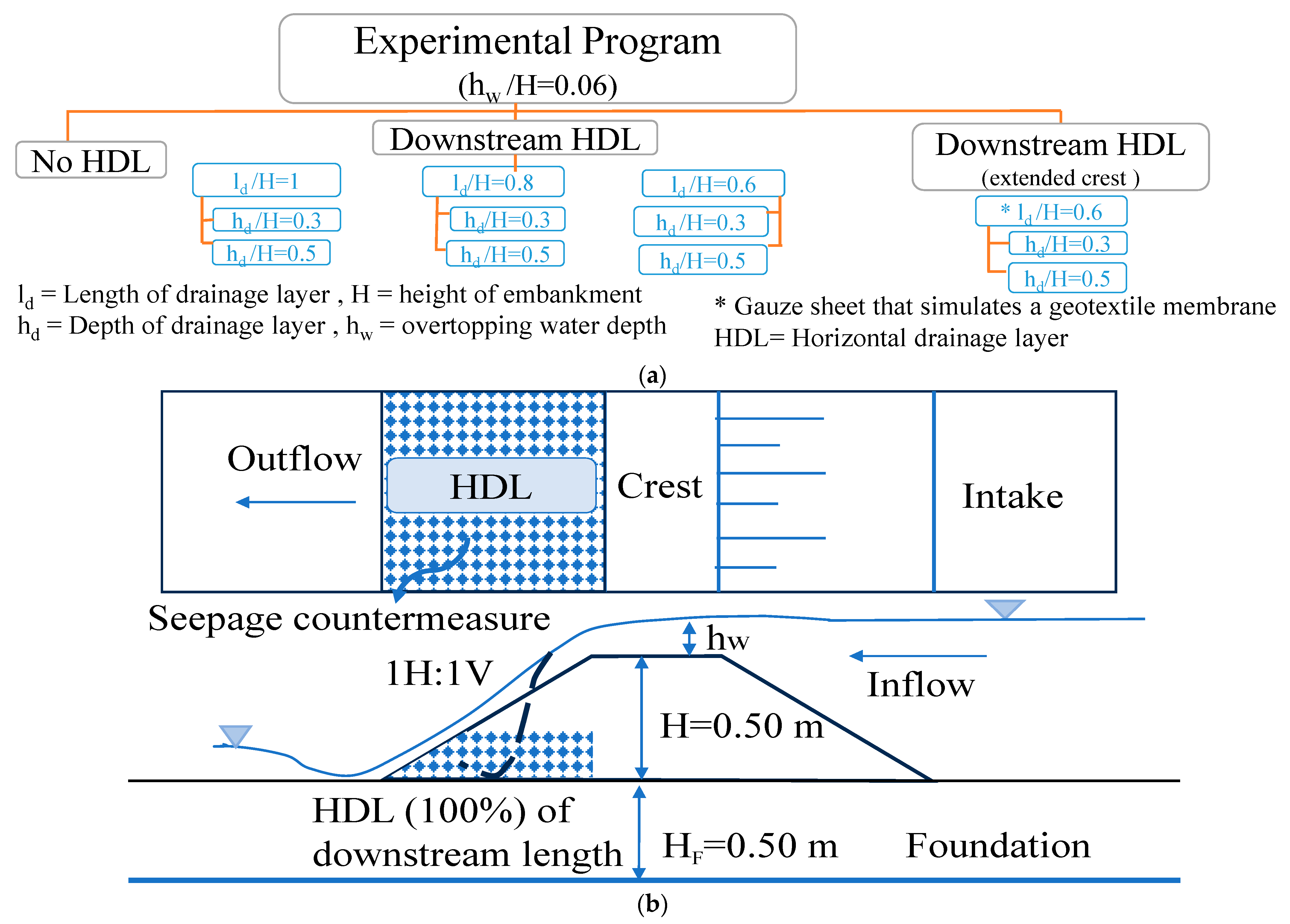
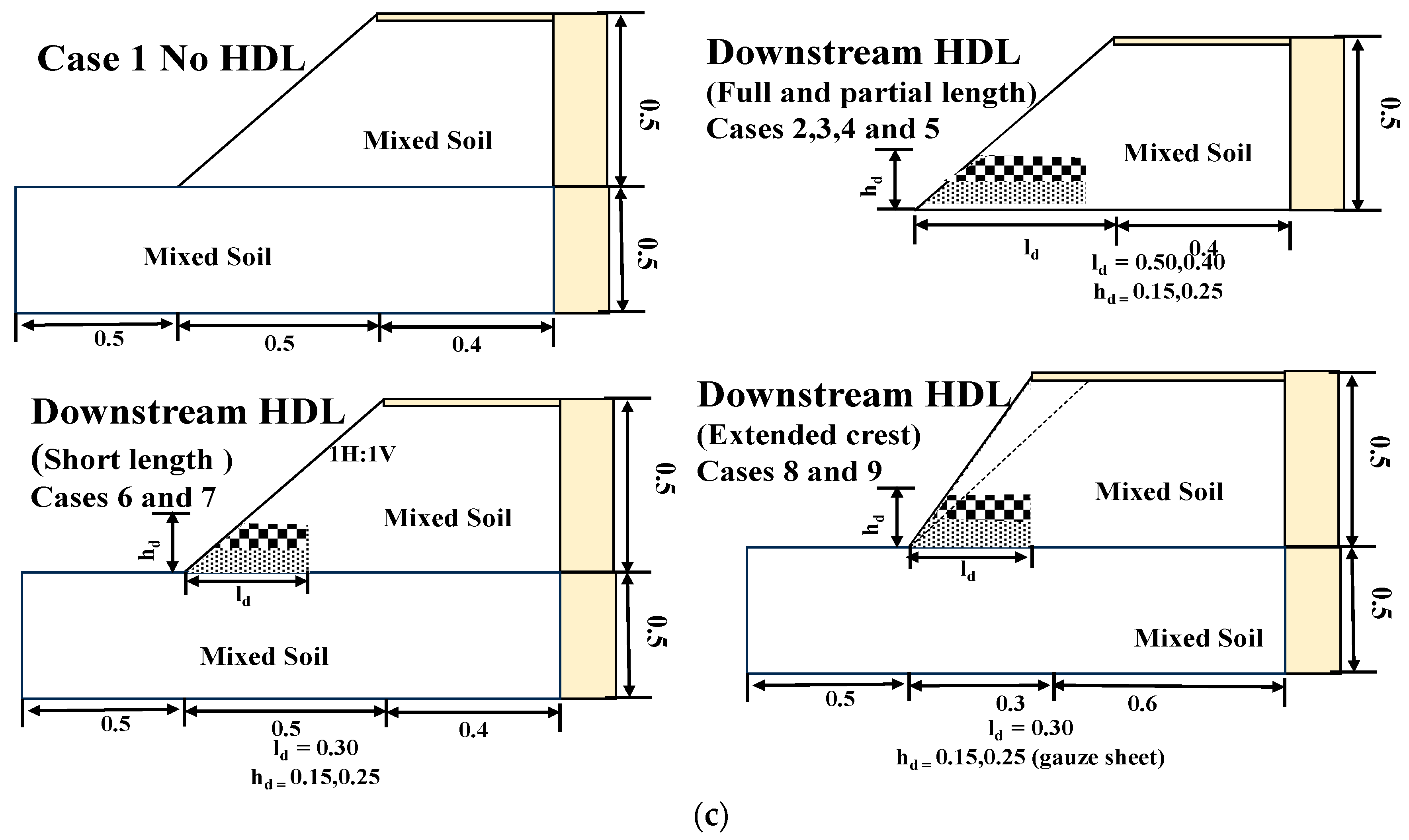
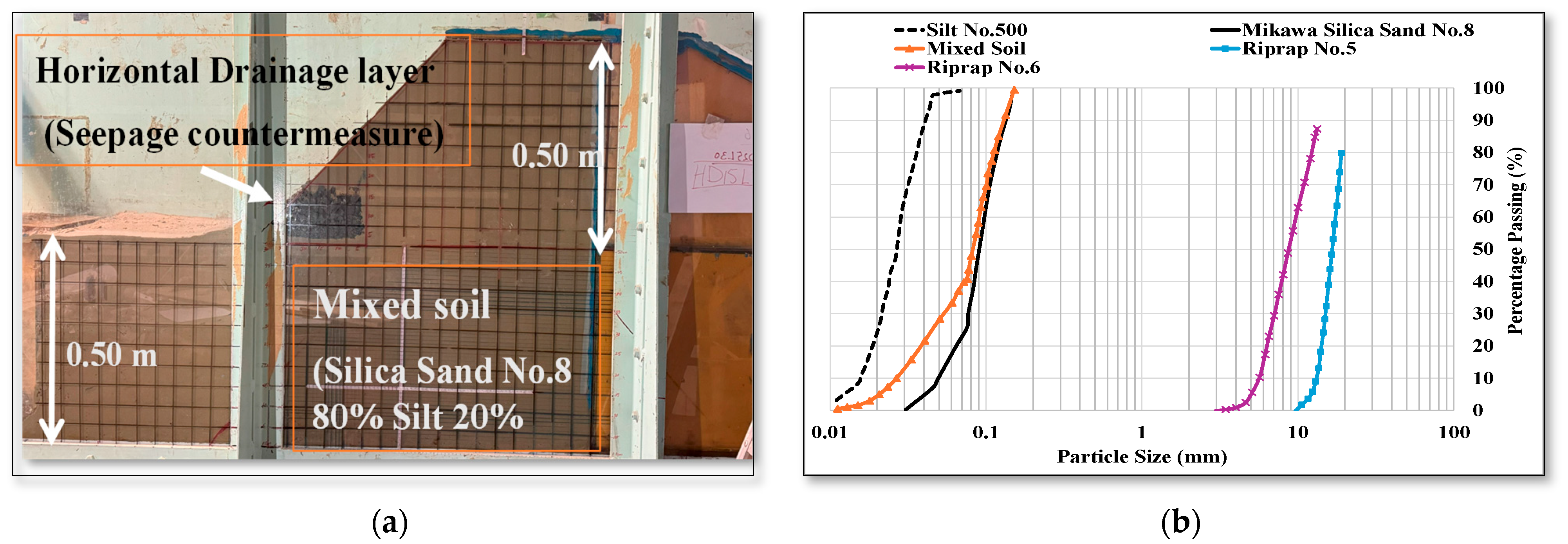
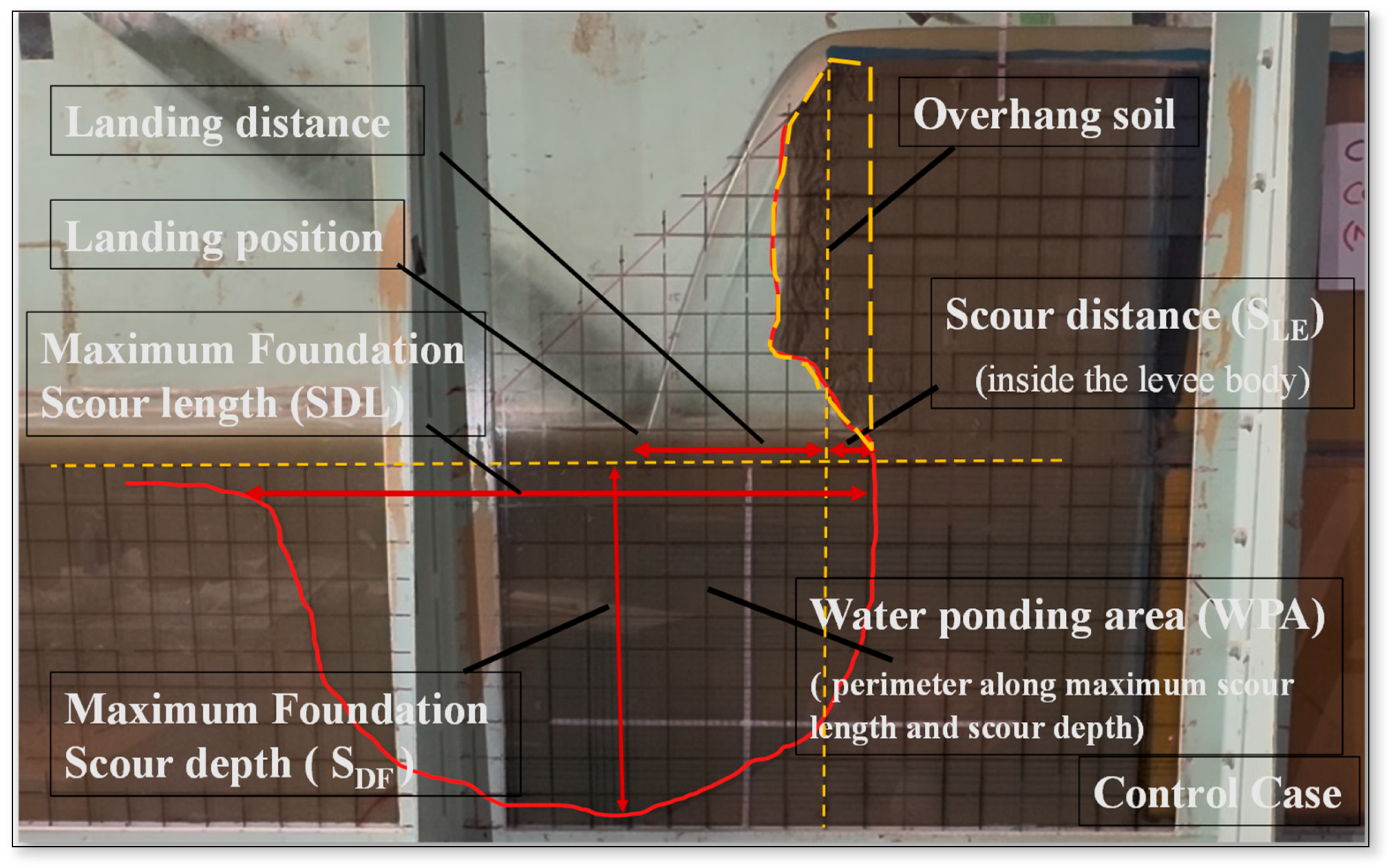
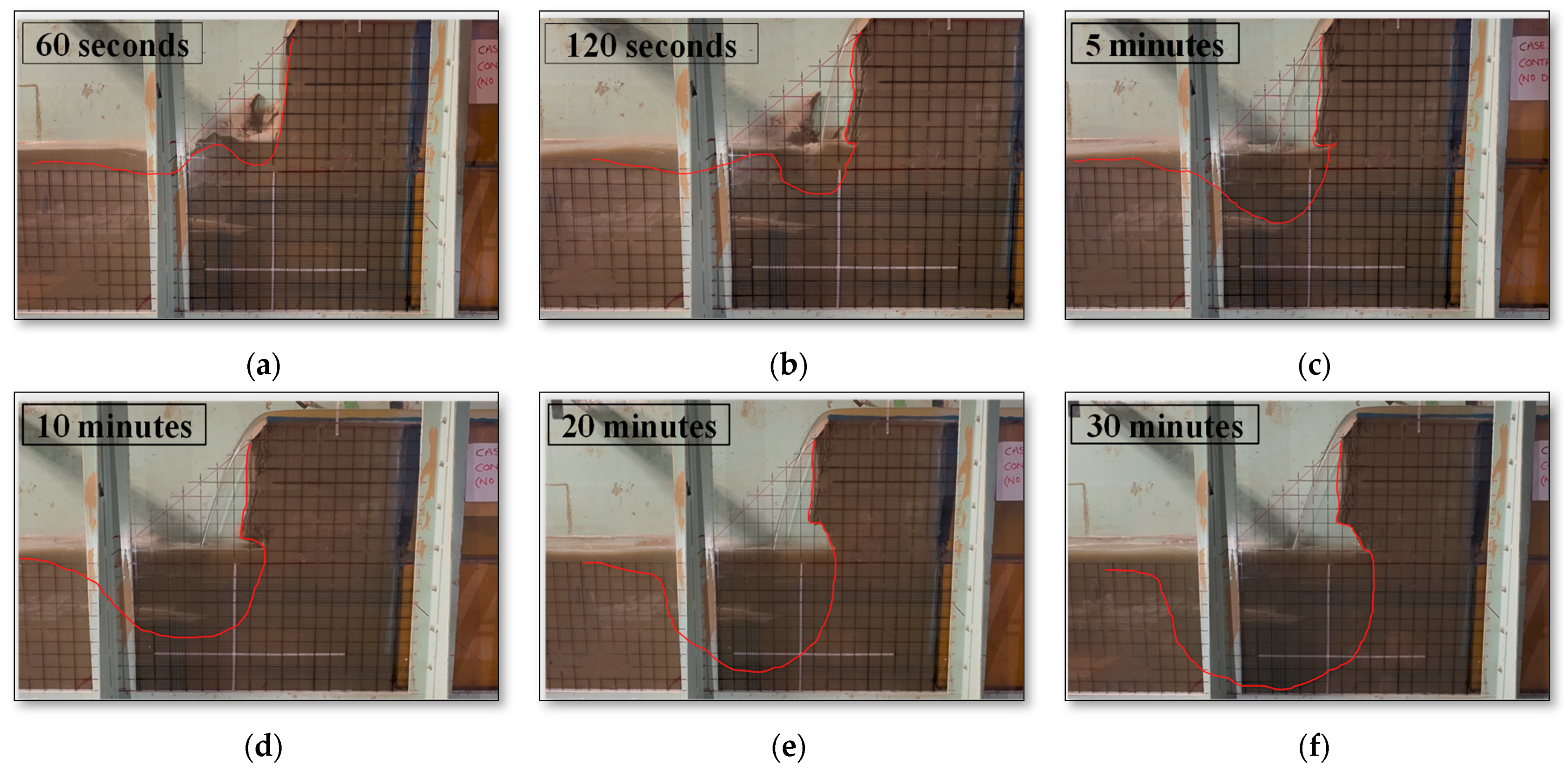
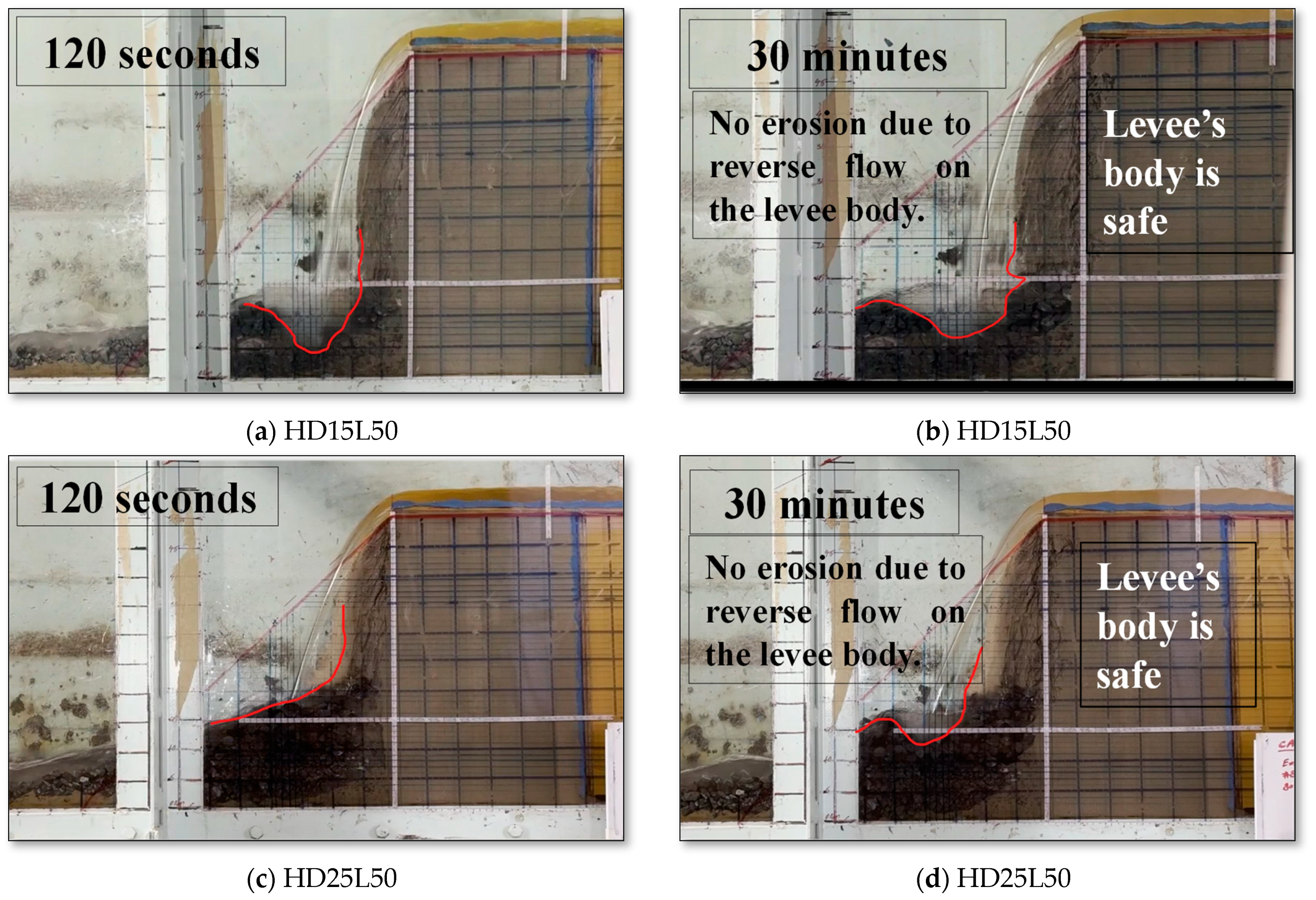
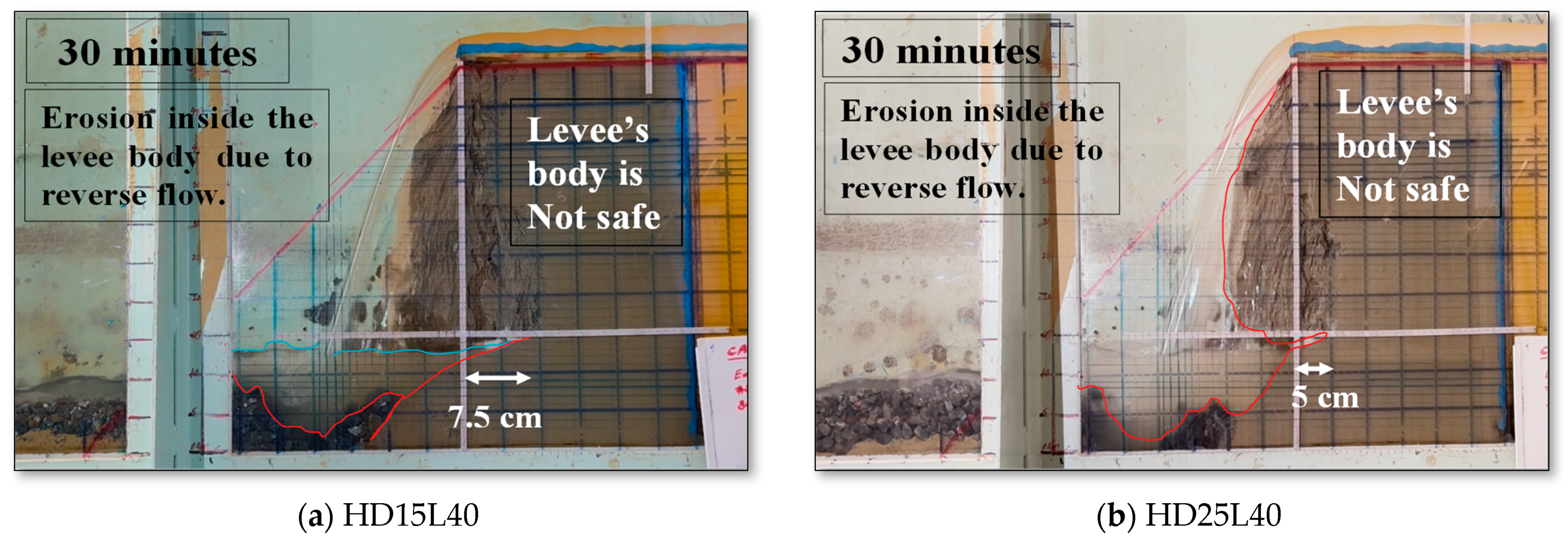
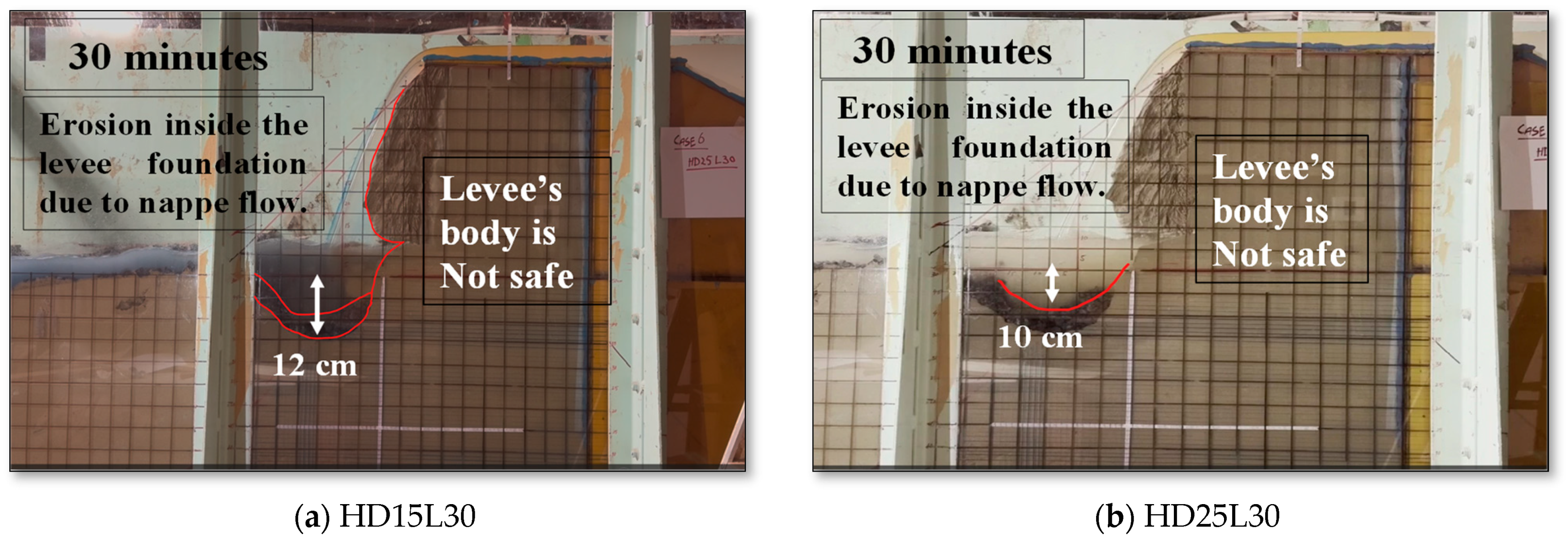
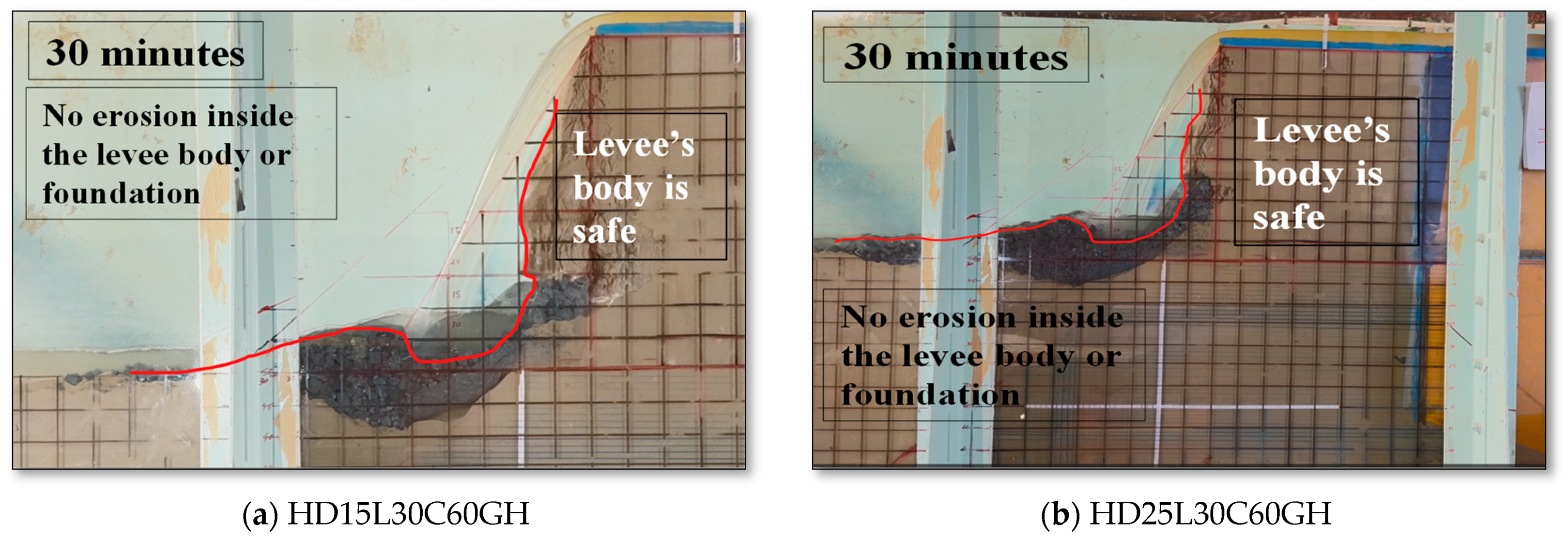
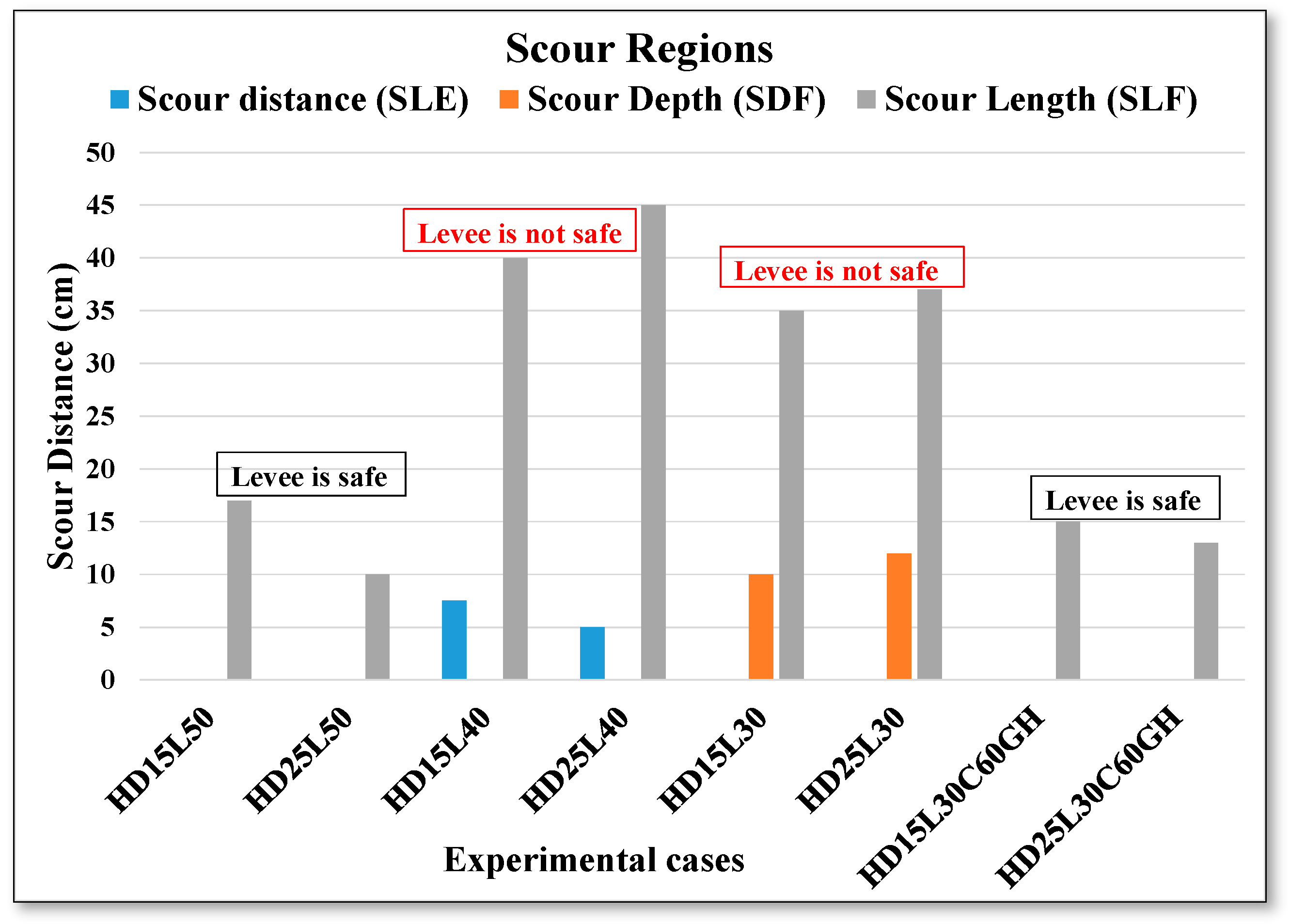
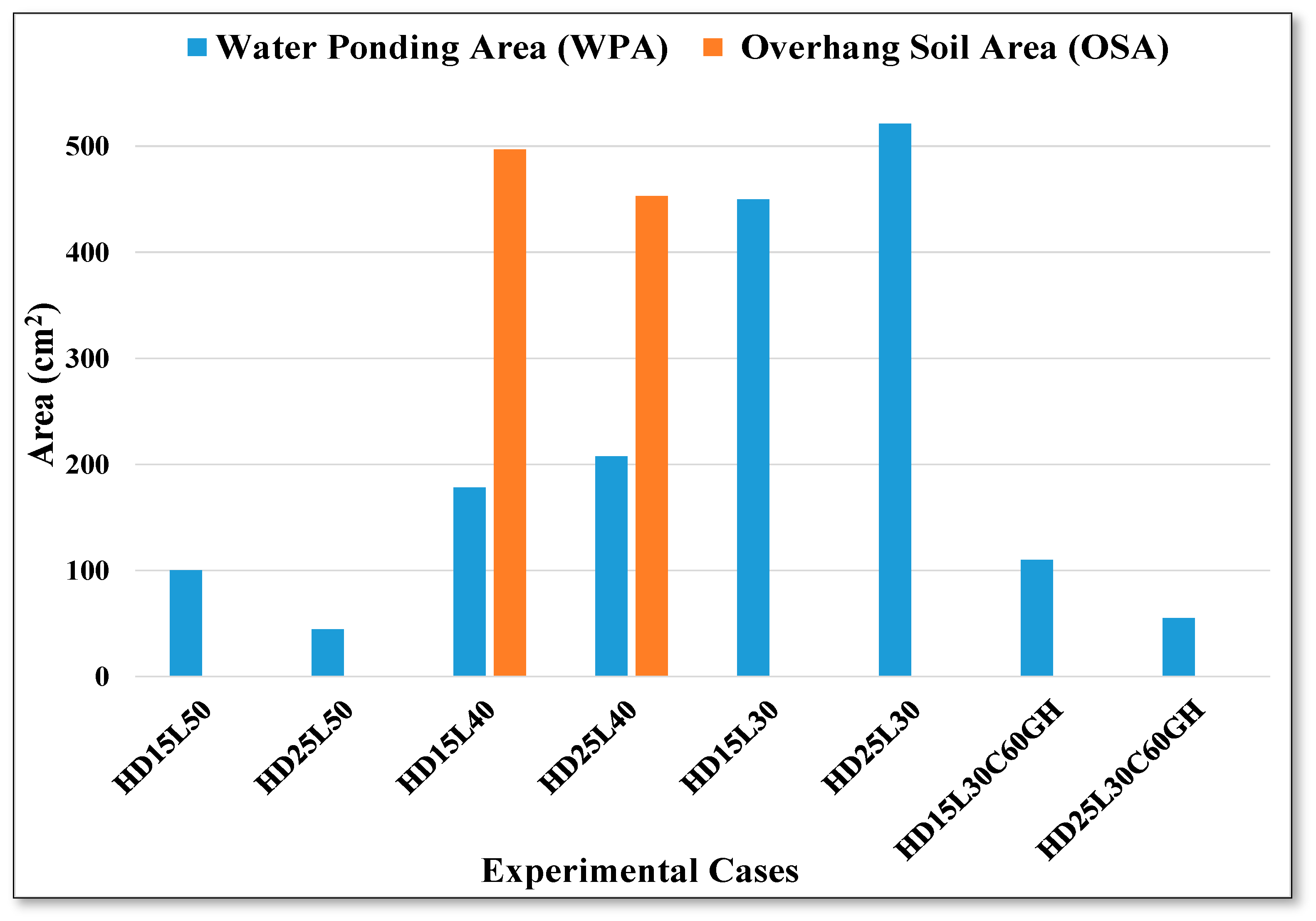
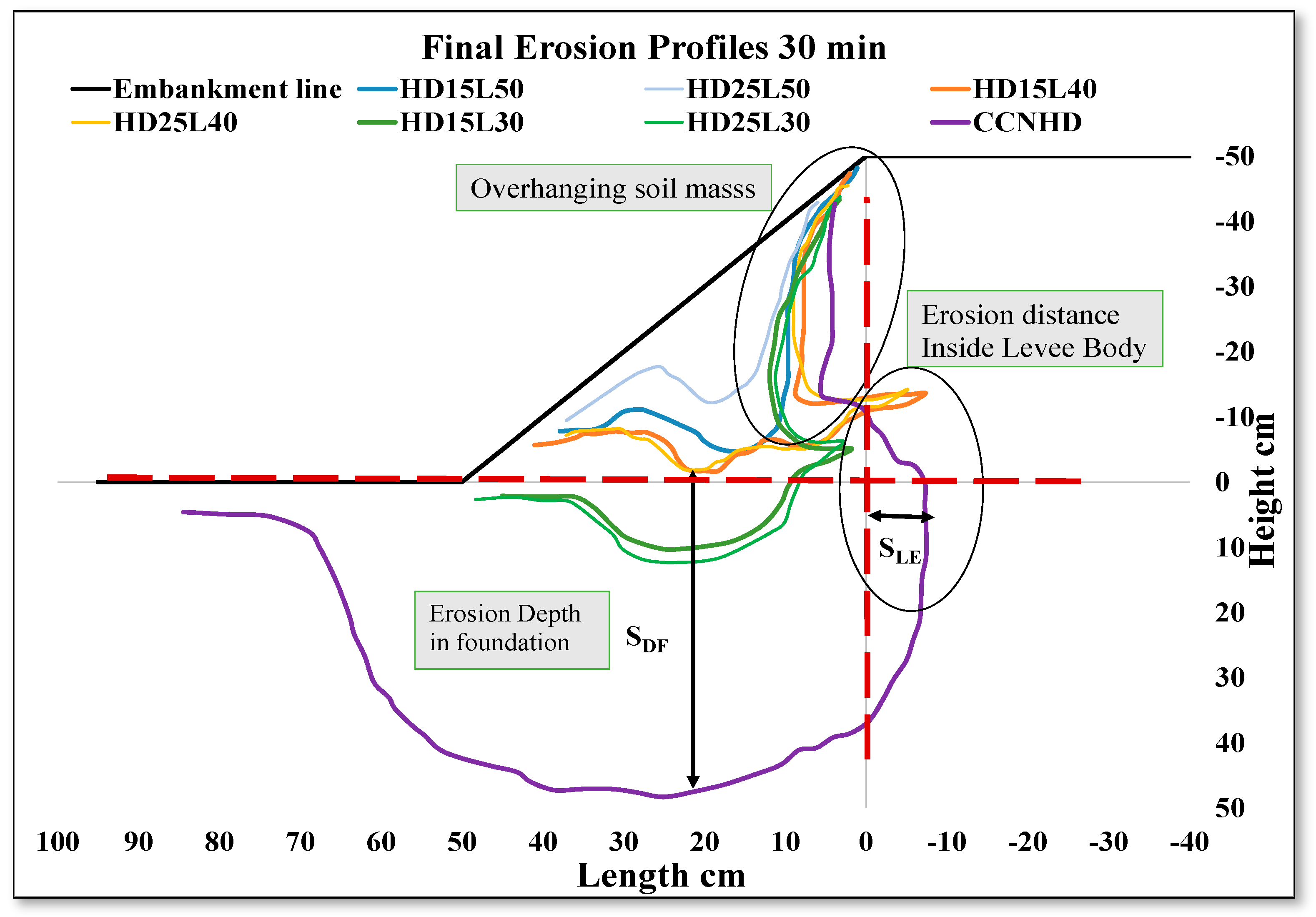
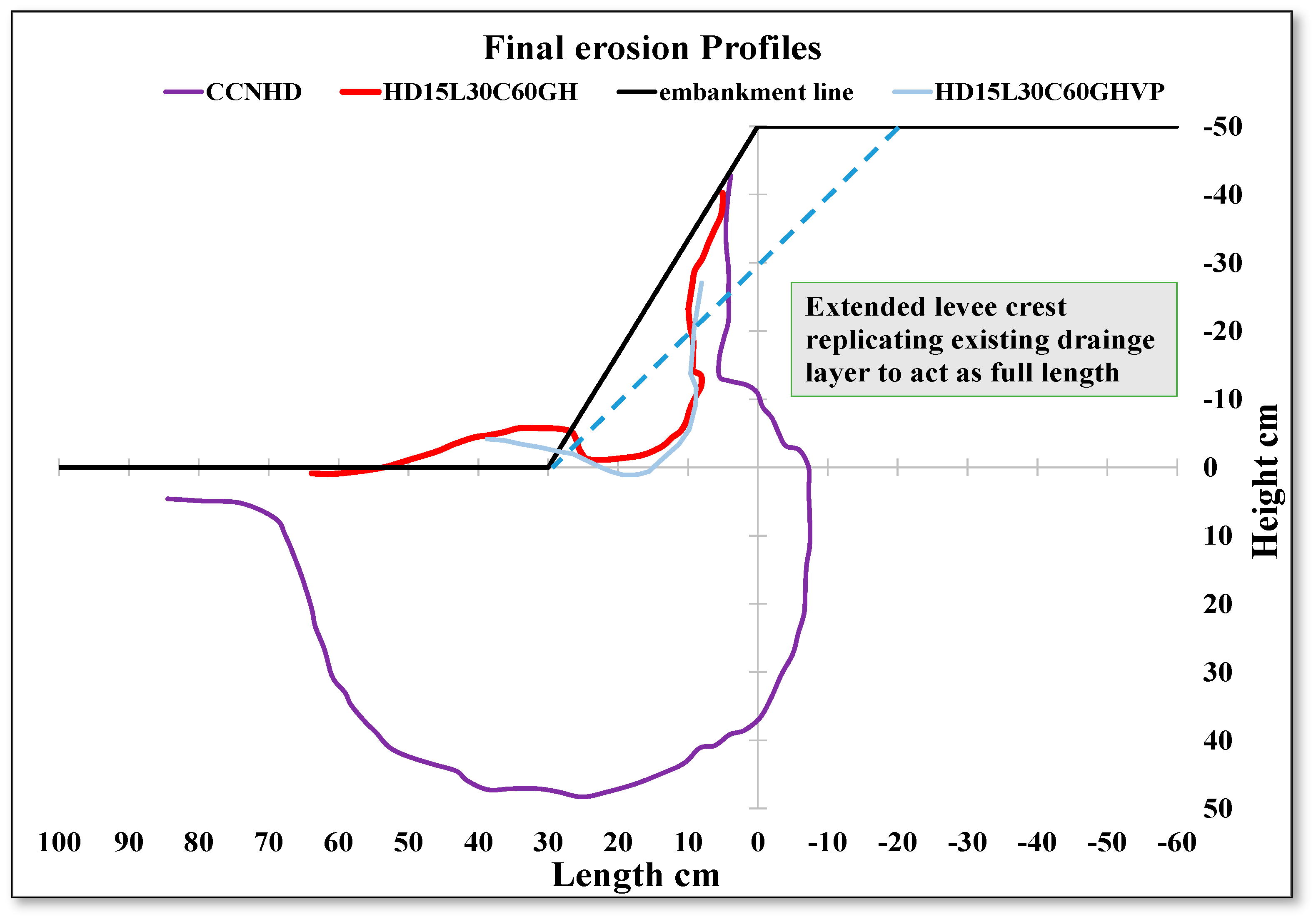
| Case Name | Type of Seepage Countermeasure (% of D/S Length) | HDL Length (cm) | HDL Thickness (cm) | HDL Material (Rip Rap No.) | Dimensions of HDL |
|---|---|---|---|---|---|
| Case 1: CCNHD | None (0) | Nove | None | None | None |
| Case 2: HD15L50 | ** HDL (100) | 50 | 15 | No.5,6 | hd/H = 0.3 |
| Case 3: HD25L50 | HDL (100) | 50 | 25 | No.5,6 | hd/H = 0.5 |
| Case 4: HD15L40 | HDL (80) | 40 | 15 | No.5,6 | hd/H = 0.3 |
| Case 5: HD25L40 | HDL (80) | 40 | 25 | No.5,6 | hd/H = 0.5 |
| Case 6: HD15L30 | HDL (60) | 30 | 15 | No.5,6 | hd/H = 0.3 |
| Case 7: HD25L30 | HDL (60) | 30 | 25 | No.5,6 | hd/H = 0.5 |
| Case 8: HD15L30C60GH | HDL (100) | 30 | 15 | No.5,6 | hd/H = 0.3 |
| Case 9 *: HD25L30C60GH | HDL (100) | 30 | 25 | No.5,6 | hd/H = 0.5 |
| Experimental Cases | Scour Dimensions (cm) | Water Ponding Area (WPA) (cm2) | Overhang Soil AREA (OSA) (cm2) | ||
|---|---|---|---|---|---|
| Scour Distance (SLE) (Inside the Levee Body) | Foundation Scour | ||||
| Depth (SDF) | Length (SLF) | ||||
| CCNHD | 8 | 47 | 75 | 2500 | 100 |
| HD15L50 | 0 | 0 | 17 | 100 | 0 |
| HD25L50 | 0 | 0 | 10 | 45 | 0 |
| HD15L40 | −7.5 | 0 | 40 | 180 | 500 |
| HD25L40 | −5 | 0 | 45 | 210 | 450 |
| HD15L30 | 0 | 10 | 35 | 450 | 0 |
| HD25L30 | 0 | 12 | 37 | 520 | 0 |
| HD15L30C60GH | 0 | 0 | 15 | 110 | 0 |
| HD25L30C60GH | 0 | 0 | 13 | 55 | 0 |
Disclaimer/Publisher’s Note: The statements, opinions and data contained in all publications are solely those of the individual author(s) and contributor(s) and not of MDPI and/or the editor(s). MDPI and/or the editor(s) disclaim responsibility for any injury to people or property resulting from any ideas, methods, instructions or products referred to in the content. |
© 2024 by the authors. Licensee MDPI, Basel, Switzerland. This article is an open access article distributed under the terms and conditions of the Creative Commons Attribution (CC BY) license (https://creativecommons.org/licenses/by/4.0/).
Share and Cite
Ali, L.; Sekine, K.; Tanaka, N. Evaluating the Effectiveness of Seepage Countermeasures and Retrofitting Strategies for Mitigating Nappe Flow-Induced Reverse Flow and Erosion for Overtopping Flow from a Levee. Geosciences 2024, 14, 233. https://doi.org/10.3390/geosciences14090233
Ali L, Sekine K, Tanaka N. Evaluating the Effectiveness of Seepage Countermeasures and Retrofitting Strategies for Mitigating Nappe Flow-Induced Reverse Flow and Erosion for Overtopping Flow from a Levee. Geosciences. 2024; 14(9):233. https://doi.org/10.3390/geosciences14090233
Chicago/Turabian StyleAli, Liaqat, Kento Sekine, and Norio Tanaka. 2024. "Evaluating the Effectiveness of Seepage Countermeasures and Retrofitting Strategies for Mitigating Nappe Flow-Induced Reverse Flow and Erosion for Overtopping Flow from a Levee" Geosciences 14, no. 9: 233. https://doi.org/10.3390/geosciences14090233
APA StyleAli, L., Sekine, K., & Tanaka, N. (2024). Evaluating the Effectiveness of Seepage Countermeasures and Retrofitting Strategies for Mitigating Nappe Flow-Induced Reverse Flow and Erosion for Overtopping Flow from a Levee. Geosciences, 14(9), 233. https://doi.org/10.3390/geosciences14090233







